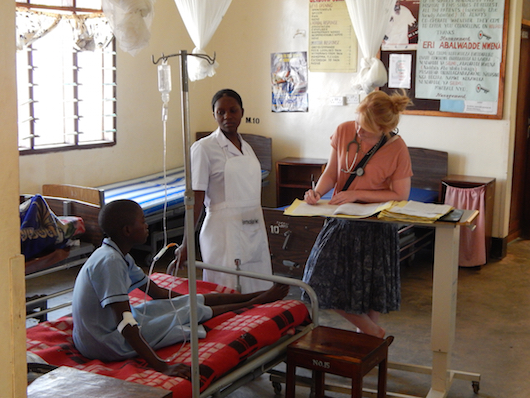This past weekend was Murchison Falls. It deserves its own separate post and also deserves pictures. Unfortunately I cannot upload over this internet connection. Suffice to say that we saw plenty of antelope, hippos, crocs, herds of giraffe, monkeys, troops of baboons, a lion, had our way blocked by a herd of elephants, and also had a cape buffalo threaten to charge our van. It was also a bit of a challenge arriving at the National Park as our clutch gave out several times and we were stranded at one point for over an hour, surrounded by Tsetse flies (whom our guide assured us “carried no diseases” — yet we had admitted a patient with African trypanosomiasis just the week before). But pictures and more later….
Today was my first day on Male Ward. I am working with Dr. Natasha. We’ve had several interesting patients, including a 10 year old who was admitted for snakebite. He stated that he had been swimming the day before (Sunday) and had felt a “bite” under water. His father had watched him for most of the day but then brought him to the hospital on that evening. He presented with a decreased level of consciousness (GCS score of 10 — which basically meant he was moaning and withdrawing from pain, but not much else) and continued to drift in and out of consciousness. He also had labored breathing. Due to this, and the history of snakebite, he was given anti-venom late last night.
Today, when the admitting physician came to see him, he was sitting up and talking in bed, no longer confused. He’d had no bleeding, and his main symptoms had been decreased respiratory rate, hypotension, confusion, and pain/swelling in his left leg (the bitten leg). He’d had no bleeding and had also been started on antibiotics (cloxacillin here staph/strep infections as they don’t have MRSA yet) the night before as well.
It didn’t really sound like a snakebite to me. For one thing, puff adders are the main snakes here, and they are in the pit viper family, similar to rattlesnakes and copperheads, which produce an anti-coagulant and not neuropathic venom. Cobras and black mambas are the other poisonous snakes here, but these produce neuropathic venom similar to coral snakes at home as they are all from the elapid family. In the US at least, the two antivenoms are very different, and in the British Formulary (used here) they are not to be mixed. No one here knows if the antivenoms are combined or separate.
However, for this patient, he’d had no bleeding. He had had neurological symptoms, but not the ones typical of snake bite, which is almost an like Guillan-Barre in that it is ascending paralysis (if bitten on a lower limb). Later today, when we rounded on him, he had a clearly red and unilaterally swollen limb and still had fevers. He had no fang marks, indeed no skin breakage of any kind on his foot, which is where he swelling was the most pronounced and where he thought he’d been “bitten.” There was definitely no signs of skin necrosis, which would be expected if he’d had enough venom injected to cause systemic symptoms. It looked much more like he had a case of bad cellulitis.
Interestingly, as we were discussing him his blood smear came back positive for malaria. This explained the fluctuating fevers and altered level of consciousness. We started him on anti-malarials as well as increasing the dose of his cloxacillin. Dr. Natasha is not convinced that it’s not snakebite, but she did hold off on any further antivenom (he became confused and disoriented a few minutes after we rounded on him, but improved greatly this afternoon after being started on his meds). More to follow on him tomorrow.
We also had a patient with blood pressures of >200/>100. He has diabetes, hypertension, and chronic renal disease. It’s just like being back home! Otherwise, many patients had gastroenteritis, HIV including cryptococcal meningitis and two with toxoplasmosis, malaria, typhoid fever, TB, and a couple of patients that we’re still trying to figure out. One of the patients positive for toxo titers also has what seems to be hemi-neglect (meaning he totally ignores/doesn’t see the left side of his visual field) as well as total left-sided weakness and persistent myoclonic jerks (meaning his left arm and left leg constantly jerk) that doesn’t respond to diazepam or phenobarb. I
Also of note, regarding blood transfusions — they don’t transfuse blood unless the hemoglobin (called Hb here) unless its lower than 5. In the States, the transfusion threshold is 7. We routinely see Hgb’s of 2 and 3, sometimes in kids who were running around and playing earlier that day. Otherwise, all’s well, back to Male Ward tomorrow.

